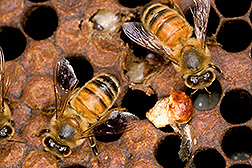This page has been archived and is being provided for reference purposes only. The page is no longer being updated, and therefore, links on the page may be invalid.
Read the magazine story to find out more. |
|
Genome Map Helping Scientists Build a Better Honeybee
By Jan SuszkiwJanuary 10, 2005
With a map of the honeybee's entire genetic code in hand, Agricultural Research Service (ARS) scientists are pursuing new ways to manage the welfare and productivity of this important insect.
After all, humans have a vested interest in Apis mellifera; the honeybee's pollination of 90-plus kinds of flowering crops each year results in yield and quality improvements valued at more than $14 billion in the United States alone. And that's not counting honey, the byproduct of such pollination.
In January, a team led by scientists at Baylor College of Medicine in Houston, Texas announced the completion of the first rough draft of the honeybee genome, which is about one-tenth the length of that for humans. Jay Evans and Katherine Aronstein, ARS members on the team, are now using information from the advance to identify immune system genes that keep honeybees healthy. Their efforts come at a time when insect pests, parasites and diseases of honeybees cause an estimated $5 million annually in crop-pollination losses.
Of particular interest to Evans, an entomologist in the ARS Bee Research Laboratory in Beltsville, Md., and Aronstein, a molecular biologist in the ARS Honey Bee Research Unit in Weslaco, Texas, is characterizing genes involved in potential resistance to the bacterium Paenibacillus larvae, which causes foulbrood disease in the insect's larvae. One tantalizing lead is abaecin, a small protein that may be part of a resistance response in some bees to foulbrood infection.
Mapping the honeybee genome opens up other exciting research avenues as well: identifying genetic markers to speed breeding of bees, such as for better winter survival; modeling host-pathogen interactions to better control honeybee disease organisms; and conducting genome-driven studies to fine-tune honey bee nutrition and pollination.
For example, by locating honeybees' olfactory genes, researchers may be able to improve the insect's diet through supplementation or improve its ability to forage for nectar longer.
Read more about the research in the January issue of Agricultural Research magazine.
ARS is the U.S. Department of Agriculture's chief scientific research agency.

